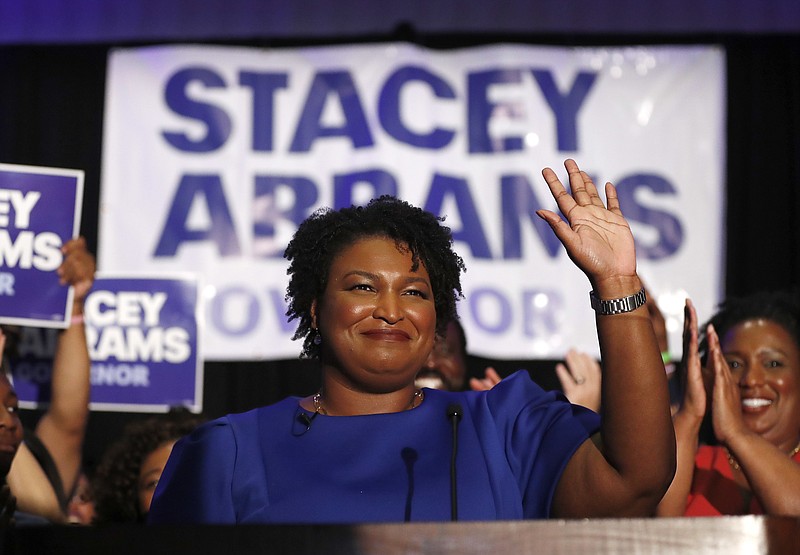You've probably heard that Stacey Abrams recently made history by becoming the first woman and the first black woman to win nomination by a major party for governor of Georgia.
But she also is the first black woman to be nominated by a major party in any state as governor.
Since Abrams' nomination came in Georgia, a reliably Republican state, becoming the nation's and Georgia's first black female governor will be an uphill climb.
She will be opposed in the race by either Lt. Gov. Casey Cagle or Secretary of State Brian Kemp. Although the state has had four previous lieutenant governors elected governor, one has not been elected in a generation. And Peach State voters have elected only one former secretary of state as governor, but that was 120 years ago.
However, Cagle would be the first Republican Georgia lieutenant governor to be elected governor.
The Peach State last elevated its lieutenant governor when Zell Miller was elected governor in 1990. He had been the state's No. 2 executive for 16 years, longer than any other man in the office.
The man who has held the office for the second longest tenure is Cagle, who will have served for 12 years if he wins the runoff with Kemp in July and beats Abrams in November's general election.
When the Georgia office of lieutenant governor was created in 1946, its first three holders went on to be governor, including Marvin Griffin, who was lieutenant governor 1948-1955 and governor 1955-1959, and S. Ernest Vandiver, who was lieutenant governor 1955-1959 and governor 1959-1963.
The third of those, Melvin E. Thompson, became involved in what the New Georgia Encyclopedia calls "one of the more bizarre political spectacles in the annals of American politics."
In 1946, Eugene Talmadge won the Democratic primary for governor for the fourth time and then the general election in November. Meanwhile, Thompson was elected the state's first lieutenant governor. However, Talmadge died before being inaugurated and before Thompson could take office.
The Talmadge forces claimed to find a "dubious constitutional and statutory precedence" that allowed the General Assembly to choose the governor in such cases, and in due course it chose Talmadge's son, Herman. Because the law said the lieutenant governor was to take office upon the death of the governor, Thompson also claimed the post.
But so did current Gov. Ellis Arnall, who said he would not give up the office until it was clear who was to be governor and because he did not believe the state constitution gave the General Assembly the right to pick a governor. Once he was chosen, though, Talmadge ordered state troopers to remove Arnall and take him to his home and changed the locks on the doors. Eventually, Arnall stepped aside and supported Thompson.
After two months of chaos, the Georgia Supreme Court ruled Thompson was the rightful governor and would be acting governor until a special election could be held in 1948. So, officially, Thompson was lieutenant governor Jan. 14-March 18, 1947, and then governor from March 18, 1947, to Nov. 17, 1948, before losing the special election to Talmadge.
Georgia also has the unusual distinction of having a sitting governor, Lester Maddox in 1970, run and win as lieutenant governor, where he served under Gov. Jimmy Carter. At the time, he could not succeed himself as governor. Interestingly, both men ran for president in 1976, Carter as a Democrat and Maddox as the nominee of the American Independent Party that had nominated former Alabama Gov. George Wallace as president in 1968.
Most recent Georgia governors have followed Abrams' path, coming directly from the General Assembly.
The Democrat is a former minority leader of the state House, where she was the first female leader of either party in the General Assembly and the first black leader in the Georgia House. She was first elected in 2007 and only resigned in August 2017 to run for governor.
Since Vandiver's term ended in 1963, seven of eight Georgia governors have served in the General Assembly, George Busbee and Roy Barnes also having been Senate floor leaders and Carl Sanders, Sonny Perdue and Deal also having been Senate presidents.
Whether Abrams' more recent legislative experience as opposed to serving in the offices of lieutenant governor or secretary of state will matter to Georgia voters is not clear.
What is clear is that Georgia voters last preferred a Democrat for president in 1992, last elected a Democrat to the U.S. Senate in 2000, last elected a Democrat for governor in 1998 and last elected a Democrat statewide in 2006.
Four years ago, Democrats believed they had primo candidates for U.S. Senate in Michelle Nunn (daughter of former Sen. Sam Nunn) and governor in Jason Carter (grandson of former President Carter), but neither came close to winning. And in a special U.S. House election in 2017, Democrats imported influential party bigwigs and glittering celebrities and poured millions into the can't-lose candidacy of telegenic Jon Ossoff for a suburban Atlanta seat, but he was defeated.
Between now and November, Abrams will be the media's darling - one website already noted "Georgia Has Practically Elected the 1st Black Woman as Governor in America!" - but in November the electorate may persuade her that she should return to her pen name of Selena Montgomery, under which she previously wrote romantic suspense novels.
